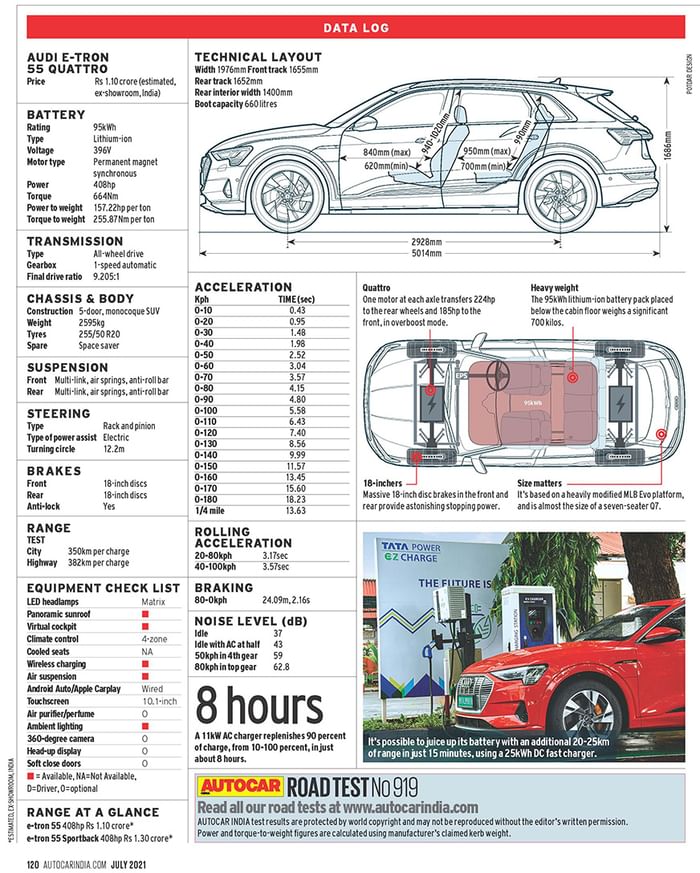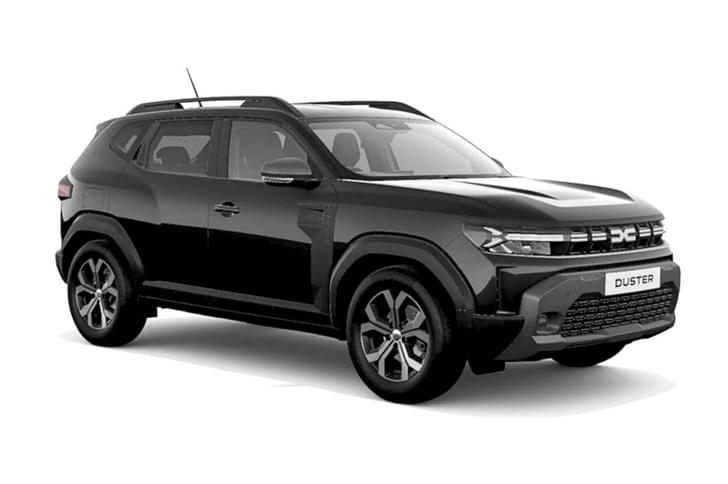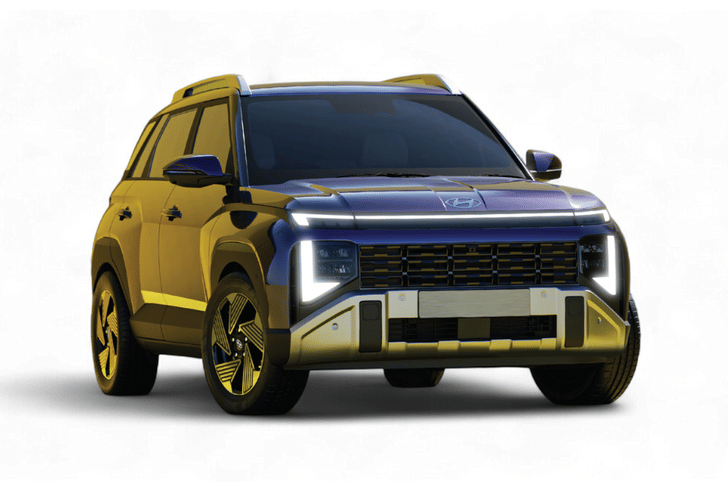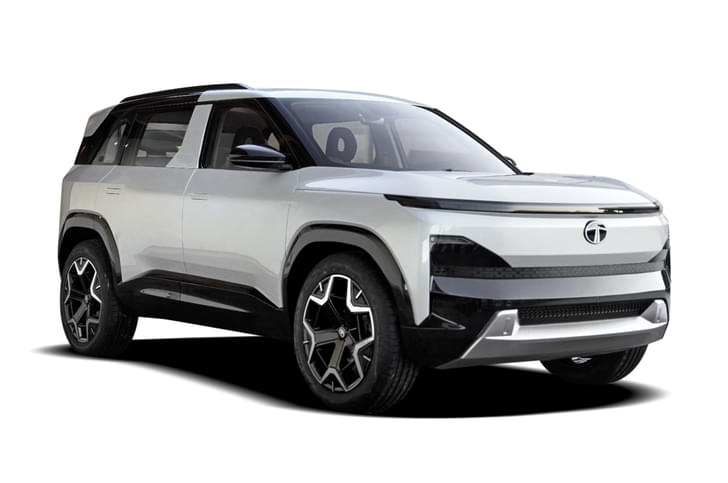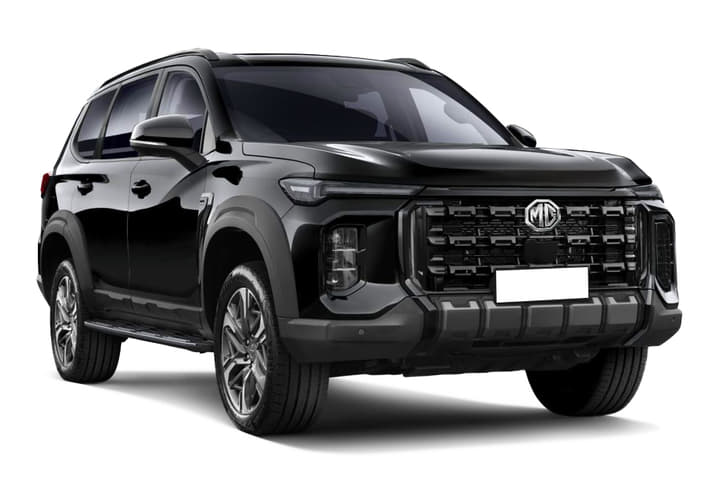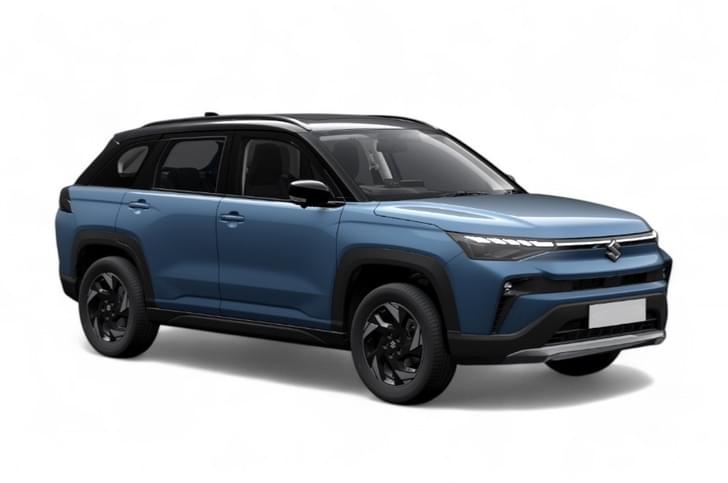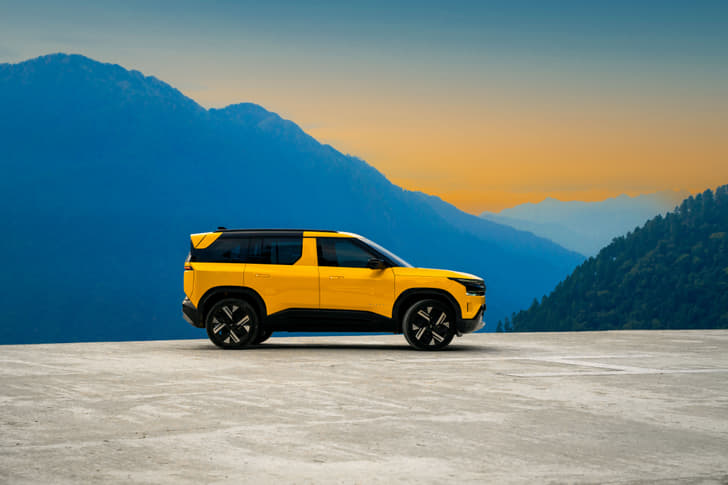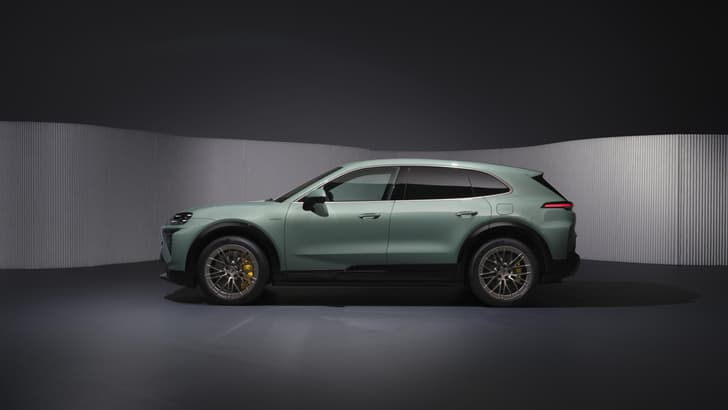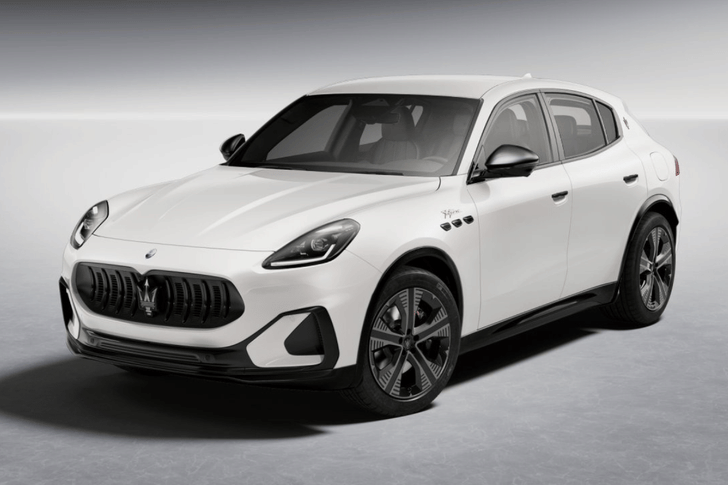What we have here is Audi’s first mass-produced electric vehicle – the e-tron. The name, however, made its debut in 2009 and appeared on several all-electric and plug-in hybrid Audi concepts, as well as on some limited-run production models. In 2018, however, at this SUV’s curtain raiser, the company paved a definitive direction for the e-tron sub-brand and, henceforth, all its present and future EVs will fall under the e-tron umbrella and flaunt the moniker in their identity; for example, e-tron 55, e-tron GT, Q4 e-tron and so on.

Also not exactly new, is the car in contention, which hit international showrooms in 2019 and set off to a strong start, but supply chain constraints resulted in soaring global waiting periods and subsequent delays. The India-launch, scheduled for 2019, was delayed and that extended further due to the pandemic. So, it is only now, in the middle of 2021, that we are finally getting the e-tron in India. As a result, despite being one of the first luxury manufacturers to have a standalone EV model internationally, Audi lost its advantage in India to both, the Mercedes-Benz, which launched the EQC in 2020, and to Jaguar, which launched the I-Pace earlier this year. For Audi, however, this could be a blessing in disguise, with the competition testing the waters for premium luxury EVs and the broader market awareness and better acceptance of EVs in India, the timing seems just right for the e-tron SUV launch.
To begin with, we will get the ‘55’ variant as well as a ‘55 Sportback’ version, both of which are powered by a 95kWh battery. Interestingly, the company aims to sell over 200 e-trons annually, which might seem like a tall order for a car that costs over Rs 1 crore. So, does it have enough to back its green plates and meet the company target? We put the e-tron 55 through our exhaustive tests to find out.
The e-tron is based on the heavily modified MLB Evo platform which also underpins the likes of the Q5 and Q7. This 5-seater e-tron is similar in terms of dimensions to the 7-seater Q7, stretching over 5m in length, almost 2m in width, and with a 2.9m-long wheelbase, thus holding a distinct size advantage over its current competition – Mercedes-Benz EQC and Jaguar I-Pace.

Being an Audi, the e-tron’s styling is typically understated, so while it looks both, sharp and smart, it doesn’t obviously scream that it is ‘electric’ or ‘futuristic’. Grabbing the limelight up front is a massive enclosed hexagonal area finished in grey that mimics a standard Audi front grille, which is in line with Audi’s conventional styling approach, rather than adopting a radical design philosophy like what Jaguar did with the I-Pace. This approach has been intentionally adapted to smoothen the transition for buyers from internal combustion engine cars to electric vehicles.
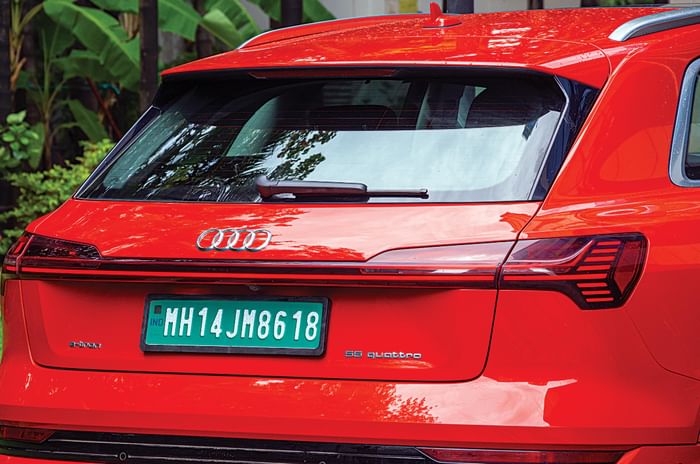
The sharply styled headlamps, bulbous haunches, and the large 20-inch wheels add some oomph to its design, and for India, we get a standard outside mirror setup, rather than the futuristic, albeit gimmicky, twin external camera setup, which we experienced in its international iteration. Uniquely, Audi provides charging provisions on either side of the car, on the front fender – the driver’s side accommodates an AC as well as a DC charging socket, whereas the passenger side gets only an AC charging socket. What’s cool is the way the flap slides down electrically, when you press the button next to the ‘e-tron’ lettering. The light bar at the rear runs the width of the boot and connects the tail-lamps, and the steeply raked rear windscreen lends it a sporty appearance. A black band on the bumper and the silver skid plate do a great job of breaking the monotone at the rear.
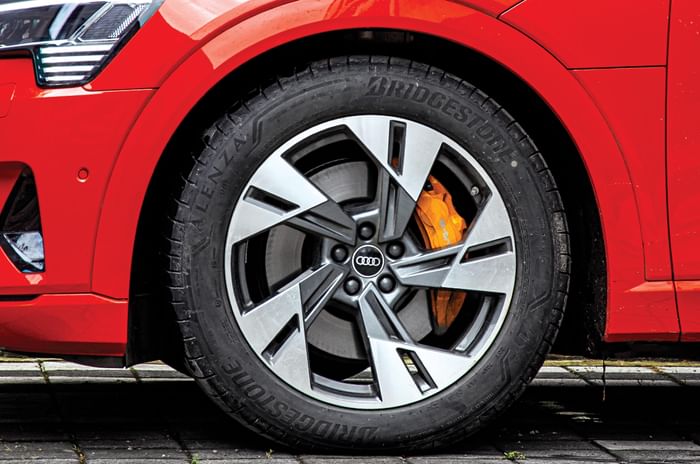
Giving away its all-electric identity, however, are the green number plates, mandated for EVs in India, and orange highlights on the e-tron badge and the brake calipers.
Step into the e-tron and you’d easily identify several design traits and shared parts with other Audis, which is no bad thing. The uncluttered, layered dashboard is pleasing to the eyes, and it nicely wraps itself around the cabin, flowing seamlessly into the door pads. The most striking detail is the twin screen setup – one for the infotainment and the other for the climate control, both of which are angled towards the driver, indicating that this SUV is focused towards the self-driven.
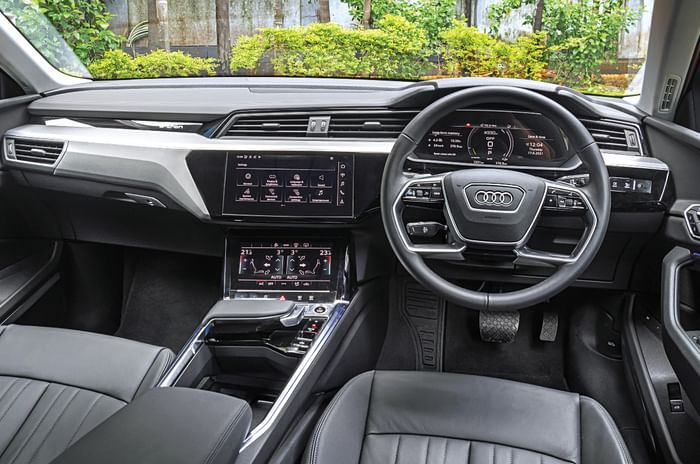
The screens have high contrast, clear displays, as well as an option for haptic feedback (mild vibration) when ‘pressed’. There’s a thoughtful rest area for your hand too, which comes handy while operating the climate control screen, but that doesn’t take away from the fact that, when on the move, you will have to look away from the road while fiddling with the blower speed or setting the temperature. What also lifts the futuristic feel of the e-tron’s interiors is the superb virtual cockpit (full-digital instrument cluster), which is one of the best units around when it comes to sharp coloured displays and ease of use.

The other bit that you’d come to appreciate is the sheer quality and fit-finish on the inside. There’s not a single low-rent area in this Audi’s cabin. The front seats are broad and accommodating, but the cushioning is a bit firm, so that you don’t sink into them, hence these don’t feel as plush or as comforting as some other luxury SUVs.
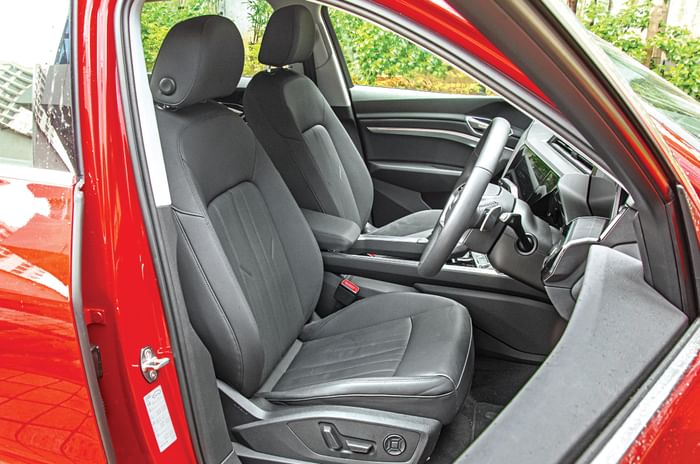
The grey colour of the seats is very business-like, and brighter coloured inserts or contrast stitching would have gone a long way to liven up its persona. Storage areas in the front are aplenty; there’s a clever recess area to wirelessly charge your smartphone while being placed perpendicularly (rather than flat); besides that is a deep cavity to stow beverage cups or even smaller bottles. In addition, the armrest console can swallow some nick-knacks, and the wide door bins will easily gobble up large bottles.
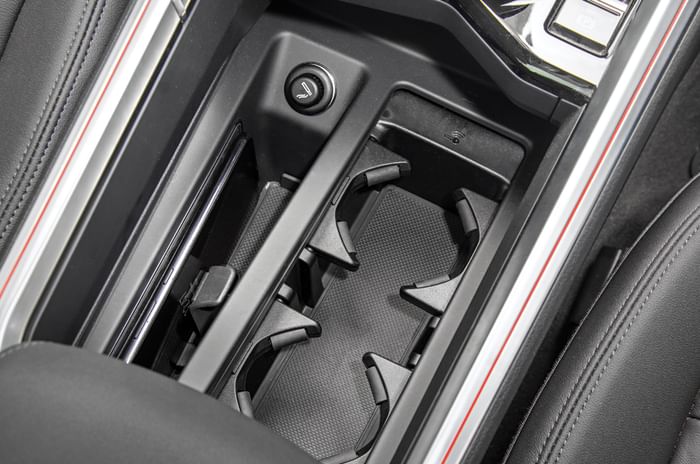
The rear bench is nicely shaped to offer adequate thigh support, and the backrest is set to a comfortable angle too. The good news is that, even though the battery pack has been accommodated beneath the floor, the floor isn’t too high-set. So, you are not seated in an uncomfortable knees-up position, nor has the headroom been compromised. The seat itself is broad enough to accommodate three passengers seated abreast and the floor is almost flat too; the protruding air-con console, however, hampers knee-room for the middle occupant. Also, the panoramic sunroof is a bit small and doesn’t stretch all the way behind, like the Jaguar I-Pace’s full panoramic glass roof.
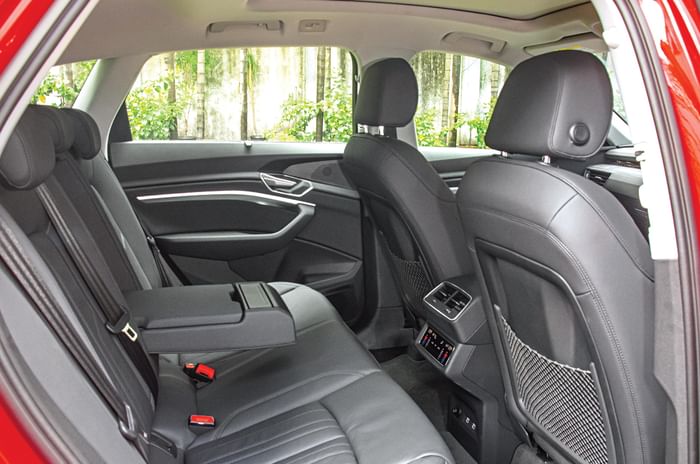
Passengers at the rear have the luxury to set their individual temperatures, thanks to the four-zone climate control. They also get two Type-C USB charging ports, cupholders in the centre armrest and large door pockets for storage. At 660 litres, the e-tron’s boot is massive. The space saver tyre is neatly tucked beneath the boot floor, where there’s an additional storage cavity to tuck in the charging cables.

What’s more is that, because there isn’t an engine under the bonnet of the e-tron, there’s an additional storage space up front, where a small soft bag can easily be accommodated or even the cables, should you prefer. The option to unlock its ‘frunk’ or ‘front trunk’ isn’t conveniently located on the key, but is at a more conventional location beneath the dashboard on the driver’s side.
The e-tron 55’s standard features list includes 20-inch wheels, Matrix LED headlamps, a panoramic sunroof, Audi’s virtual cockpit (fully-digital instrument cluster), twin screens – one for the infotainment and the other for climate control – both offering haptic feedback. In addition, you get a four-zone climate control, air suspension, wireless charging, Android Auto and Apple CarPlay (wired) and an electric tailgate.

Audi offers a laundry list of optional features which include a 16-speaker, 705W Bang and Olufsen premium sound system, a 360-degree camera, head-up display, on-board air purifier and perfume, ambient lighting with 30 colour options, and soft-closing doors. Then there are the optional digital Matrix LED headlamps which have a cool trick up their sleeve – apart from lighting up the road very well, these also perform a theatrical light show whenever you lock/unlock the vehicle.
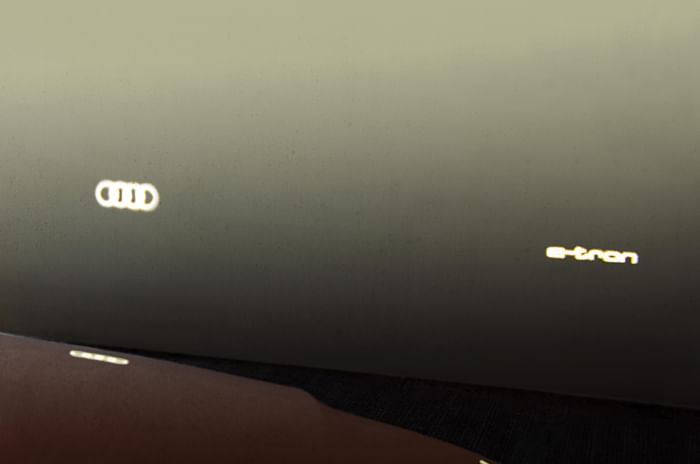
Features such as ventilated seats, wireless phone connectivity and connected car tech, to name a few, are missing, and users who seek deeper and geeky EV-related information on the screens will be left a bit shortchanged with the oversimplified displays on offer.
The 10.1-inch touchscreen is easy to use and it responds well, without any perceptible lag. Touch inputs, however, command some pressure and aren’t feather-light like some modern touchscreens. What’s nice is that it offers an option for a vibratory feedback on click.
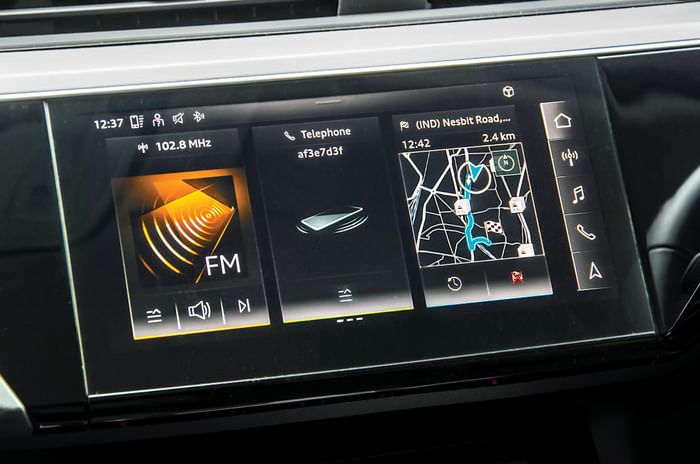
Owners will appreciate its oversimplified interface, but those who prefer a variety of EV-related information and displays will certainly be left wanting for more data analytics and screen options. One of its talking points is the 16-speaker 705W Bang and Olufsen sound system, which delivers a clear, yet punchy audio experience.
In the ‘e-tron 55 quattro’ guise, this SUV draws power out of a 95kWh battery pack that supplies energy to two motors, one on each axle. In its sportiest setting, the e-tron generates 408hp/664Nm, 184hp at the front axle and 224hp at the rear. But in other modes, the e-tron makes 360hp/561Nm (170hp in the front and 190hp at the rear). The part-throttle rolling responses from standstill are so nice and gentle, that you’ll even forgive Audi for not offering a standard creep function. Being an EV, of course, torque is served right from the get-go, acceleration is very brisk, and the throttle response is sharp. A mere flex of your right foot is enough to scoot past slow-moving traffic, with the type of gusto you’d least expect from a 2.6-tonne SUV. The smooth, yet consistent build up of speed and its instantaneous responses are very addictive. This all-electric SUV can be enjoyed without the slightest guilt about polluting the environment, thanks to its zero tailpipe emissions. Interestingly, through external speakers, the e-tron plays a whirring-like sound in order to alert pedestrians and other road users of its presence on the move.

Switch from D to S and this Audi unleashes the additional 48hp/103Nm in overboost mode, under hard acceleration. When driven flat-out, the 2.6 tonne e-tron gallops from 0-100kph in a blisteringly quick 5.58sec and pulls strongly till about 180kph, after which the acceleration graph tapers off. With your foot pinned to the floor, it will max out at 207kph, as suggested by our GPS-based test equipment.
As with all EVs, the e-tron has energy regeneration (where the motor acts as a generator and recuperates kinetic energy during off-throttle coasting and braking) and it has two settings, manual and auto. What’s really impressive is how intuitive and how natural the auto mode is when you lift off. It allows the car to coast in order to maximise the distance covered, or it will recuperate charge and decelerate the car, all based on the driving style and battery state. What’s more is that if you need to slow down a bit sooner, you can tug at the left paddle and momentarily increase the regeneration and braking feel. Conversely, if you feel the braking feel is too strong, tug at the right paddle to decrease the braking feel and regeneration.
In addition to auto mode, there’s an option to manually turn regeneration off, or set it to two preset levels, which keep retardation forces at 0.03g and 0.1g, respectively. Using level 1 is a good idea during continuous downhill descents while in stop-go scenarios, using the higher setting could be fruitful where the car will decelerate rather rapidly on lift off, considerably slowing you down. But it does not come to a full stop and thus one pedal driving (not using the brake pedal) isn’t possible.
As with most EVs, using the brakes first brings in motor retardation, and Audi states that 90 percent of the time it will be the motors alone that will provide deceleration. Even when you do use the brake pedal, the wheel brakes are only called to duty during rapid deceleration (above 0.3g force). What’s nice is that the blending of the motor and wheel brakes is smooth and very well done, you never really notice the point when the wheel brakes kick in.
We subjected the e-tron to our standard Autocar city cycles, during which we toggled between max regeneration set manually in one run, and full auto setting in the other. However, in both cases, the ‘Efficiency’ drive mode was used and we had set the climate control to 22degC. We also used the infotainment system, and occasionally the wipers and lights too, which run off the additional 12V battery. Over our city runs, the e-tron averaged a healthy 350km driving range, which is more than adequate for the urban grind, making the e-tron a competent daily driver.
In our highway cycle, with regeneration set to auto and in ‘Efficiency’ drive mode, it returned 382km of range. While short outstation excursions won’t pose much of a challenge for the e-tron, long, inter-city commutes certainly could, owing to the under-developed public charging infrastructure. One must also bear in mind that inclines consume a high amount of energy, thus adversely affecting an EV’s range; so outstation trips to hill stations will need careful planning.

If you are running really low, there is also a ‘range mode’ option, which when selected, switches the climate control off, reduces power consumption, and limits the max speed to 90kph, which can provide an additional 40-60km of driving range.
As standard, the e-tron is available with two home charging options – the standard 15amp wall socket and an 11kW wall box provided by Audi. Additionally, you can specify your e-tron with higher-wattage, 22kW AC fast-charging capability unlocked from the factory, which would significantly reduce charging times. We tested the 11kW AC wall box charger, and the e-tron replenished 90 percent of its battery from 10-100 percent in around 8 hours.
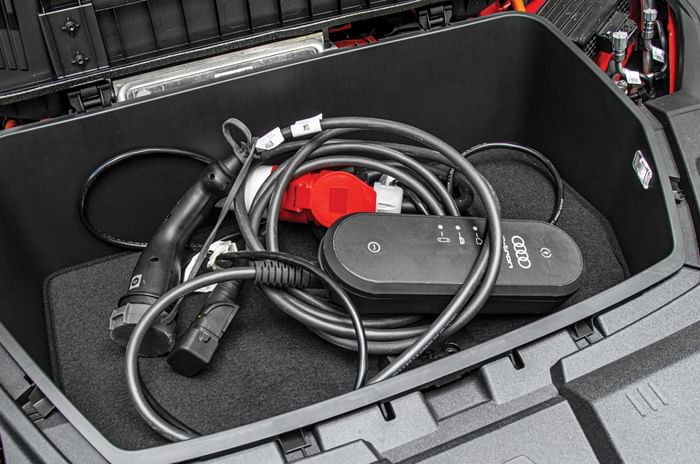
We also tested its charging at a 25kW Tata Power DC public fast charger, and a mere 15 minutes delivered about 8 percent of charge, enough for a range of about 25-30km, the cost being Rs 106. Average charging bills at home are likely to be in the region of Rs 900 per full charge (0-100 percent), taking into account a high electricity slab of Rs 10 per kWh.

It’s possible to juice up its battery with an additional 20-25km of range in just 15 minutes, using a 25kWh DC fast charger.
In order to reach its sales target of 200 units a year, the e-tron will not only have to be a very good EV, but it will also have to deliver as a regular premium SUV. As the latter, it does the job very well – it looks the part, it is spacious and practical, the ride is excellent and performance is very strong. SUVs, however, are also expected to be great long-distance cruisers. While the e-tron’s performance and handling most certainly make it well-suited for the highways, its 382km of highway range isn’t sufficient enough, which is the case with other EVs in its class too.
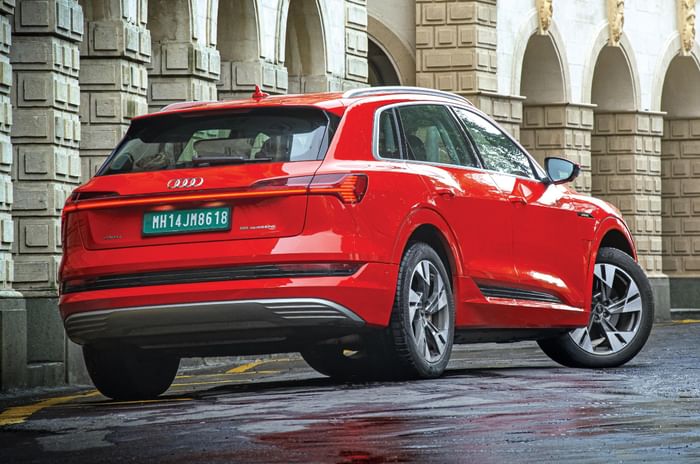
Remove the long-distance commuting from the equation, however, and it performs very well as an urban EV. A real-world city range of about 350km makes it more than capable of the routine urban grind, and performance is as smooth and as strong as it gets. So if it’s an easy-to-drive luxury SUV that you seek, one which you’ll enjoy driving without having the slightest guilt of harmful tailpipe emissions, the e-tron deserves a good hard look.
In order to reach its sales target of 200 units a year, the e-tron will not only have to be a very good EV, but it will also have to deliver as a regular premium SUV. As the latter, it does the job very well – it looks the part, it is spacious and practical, the ride is excellent and performance is very strong. SUVs, however, are also expected to be great long-distance cruisers. While the e-tron’s performance and handling most certainly make it well-suited for the highways, its 382km of highway range isn’t sufficient enough, which is the case with other EVs in its class too.
Remove the long-distance commuting from the equation, however, and it performs very well as an urban EV. A real-world city range of about 350km makes it more than capable of the routine urban grind, and performance is as smooth and as strong as it gets. So if it’s an easy-to-drive luxury SUV that you seek, one which you’ll enjoy driving without having the slightest guilt of harmful tailpipe emissions, the e-tron deserves a good hard look. Audi has priced the e-tron 55 Quattro at Rs 1.16 crore, with the 50 Quattro coming in at Rs 1 crore (ex-showroom, India).
